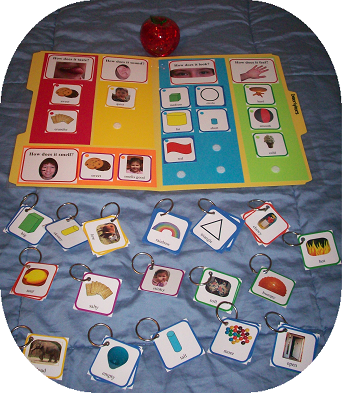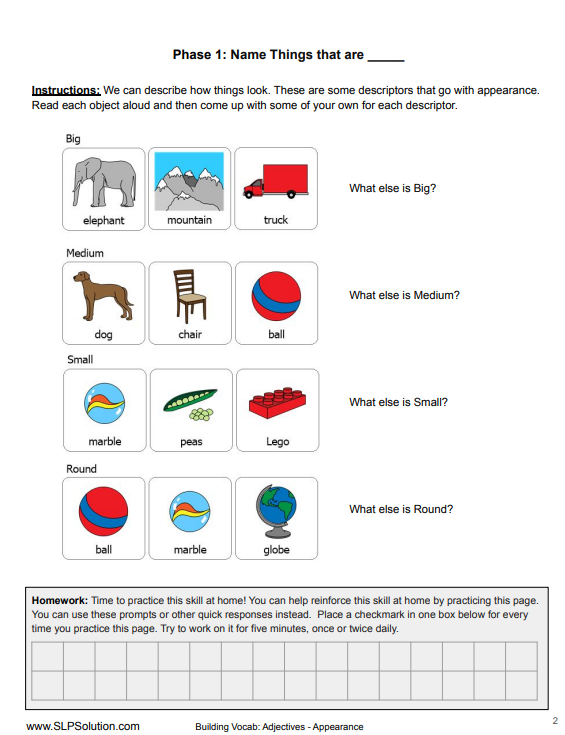Adjective Games Short Description:
This adjectives file folder game will help you use your five senses to describe an object. These adjective games are great for teaching a child how to use descriptive vocabulary when talking about an object. Picture representations of the adjectives will help children with language delays.
Adjective Games Materials Needed:
- One File Folder
- Paper to print this file
- Adhesive Velcro (such as dots or strips, can be found at walmart or craft stores)
- Metal binder rings if desired to hold cards together
Adjective Games Assembly Instructions:
1. Print out pages 4 and 5 on regular printer paper. Glue these pages inside a file folder as pictured above. If desired, laminate the file folder for added protection.
2. Print pages 6, 7, 8 on card stock or thicker printer paper. If desired, laminate these pages for added protection. Cut out each square and attach a piece of Velcro to the back of each one. If you want, punch a hole in each card and attach all of the cards of the same color together on a ring. Find the square that says “rough” and add a piece of scratchy Velcro to the front of this card. When you’re using this card, you can have your child feel the Velcro for the word rough.
3. Place Velcro pieces on the file folder as pictured above. Put two pieces in the taste, sound, and smell categories, place 8 pieces in the sight category, and place 4 pieces in the feel category. Make sure to use the opposite side of the Velcro from the ones you put on the pieces.
4. Use the game as described in the instructions on the following pages. Choose one skill that your child needs to work on and do the activity for that skill.
Adjective Games: How to Play
1. Pick an object. Have your child pick any object in the room to talk about or choose from a bag of objects that you have pre-selected.
2. Ask your child to describe the object in whatever ways that he can. Ask him to tell you every-thing he can think of about that object.
3. Next, get out this game board. Open it up and explain how we can describe things using all of our five senses. Get out the cards and separate them by sense (they are color coded).
4. Go through each set (group them on rings if that helps) and decide which one(s) fits the object you have selected. Example: Go through the color deck and pick the color that best matches the object. Take that color off the ring and Velcro it to the board.
5. Go through each set until you have all of the applicable descriptors on the board. Now, have your child describe the object again using all of the great vocabulary he has just practiced.
Adjective Games: Alternative Game Play Ideas
Describing Similarities and Differences:
Make two boards and fill each one out for a different object. Now, talk about which descriptors are the same and which are different. Example: They are both red but one is a circle and the other is a square.
Answering Questions:
Once you use the board to describe the object, ask the student questions about the object. You can work on yes/no questions as well as “how” questions. (How does it feel?). You can also ask “what” questions, such as “What else tastes sweet?” or “What do you hear with?”
Increasing MLU with Grammatical Markers:
- Pronouns: Help your child use complete sentences with correct pronouns when talking about the object. Your child can say “I see a green apple” or ”She has a bumpy ball”.
- Possessive Pronouns: Make more than one board and take turns talking about each others’ objects. Example: “Mine is red and hers is blue. Your ball is bumpy and his ball is smooth. Ours both taste sweet.”
- Articles: Make sure your is using correct articles during this game: “I have A green ball. Who has THE red one?”
- Using Helper Verbs: Make sure your child is using all the small verbs that we use in sentences like “is”, “do”, “have”, etc.: Examples: Who has the soft one? “She DOES”. –or- “IT’S a purple cup”.
Following Directions:
Help your child follow multi-step directions to complete the game: “Find the red piece, take it off the ring, and Velcro it to the board”.
Pragmatics:
During this game, your child can practice turn-taking and good topic maintenance. She can also work on collaboration skills by discussing each descriptor with the other people (or you) to decide which one fits the object.
Guessing Games (vocabulary, word finding, pragmatics, turn-taking):
You can also use this board as a reference for guessing games. One person must describe the object without using its name and the other must guess what the object is. This is great for children who need to remember to include enough information for the listener to under-stand what they are talking about. It is also great for working on vocabulary and word-finding as the child must recall the name of the object in order to guess what it is.

About the Author: Carrie Clark, MA CCC-SLP
Hi, I’m Carrie! I’m a speech-language pathologist from Columbia, Missouri, USA. I’ve worked with children and teenagers of all ages in schools, preschools, and even my own private practice. I love digging through the research on speech and language topics and breaking it down into step-by-step plans for my followers.
Fun Fact: When my son was three, he once got mad at me and told me he was going to send me to Antarctica in nothing but a t-shirt. He had an overly large vocabulary for a 3-year-old….along with an overly large amount of sass. He still has both to this day.
Connect with Me:





Hello! I really like this game! I am an undergrad student and I have a client that I work with and she will love this game. I noticed that the cards for Yellow and Orange both have the wrong color. Also there are no pictures for rough or soft. Thank you for the awesome game!
Someone just let me know about the colors being off, I’ll have to work on that. If you would like an editable version in the meantime, you can contact me at SpeechAndLanguageKids@gmail.com. For the “rough” and “soft”, you are supposed to attach small pieces of velcro to those cards. One side of the velcro should be softer and one rougher. This is better for comprehension than trying to show a picture of something that is rough and soft. Thanks!
I seem to be having a problem. The squares with “soft” and “rough” are empty. 🙁 I tried to download it again and it is having the same issue. Any suggestions? I love the activity and can’t wait to use it. Thank you.
not sure if you saw the comment above but she said attach soft and rough sides of velcro to those cards 🙂
I’ve purchases a monthly membership. But I still don’t know how to download this game.
Hi, Chad-We have emailed the game that you were looking for. Please let me know if you need anything else.
hi. this activity seems to help me alot but i am unable to download any of free downloads. kindly help me with this.
Hi, Tehreem-We will be sending you the requested downloads via email.
Will you send me a copy please? this activity is great!thank you so much
Hi, Shoma-This resource has been emailed to you.
Hi, I didn’t receive the materials
Hi, Kim-We have emailed you the requested materials. Please let us know if you need anything else.
Hi, I haven’t receive the materials.
Hi, Hazirah-We’ve just sent you a copy of the request materials via email. Please let us know if you need anything further.
Hi, I haven’t receive the materials for tell me about it
Hi, Joanne-Please check your inbox, as we have emailed to you the requested materials.